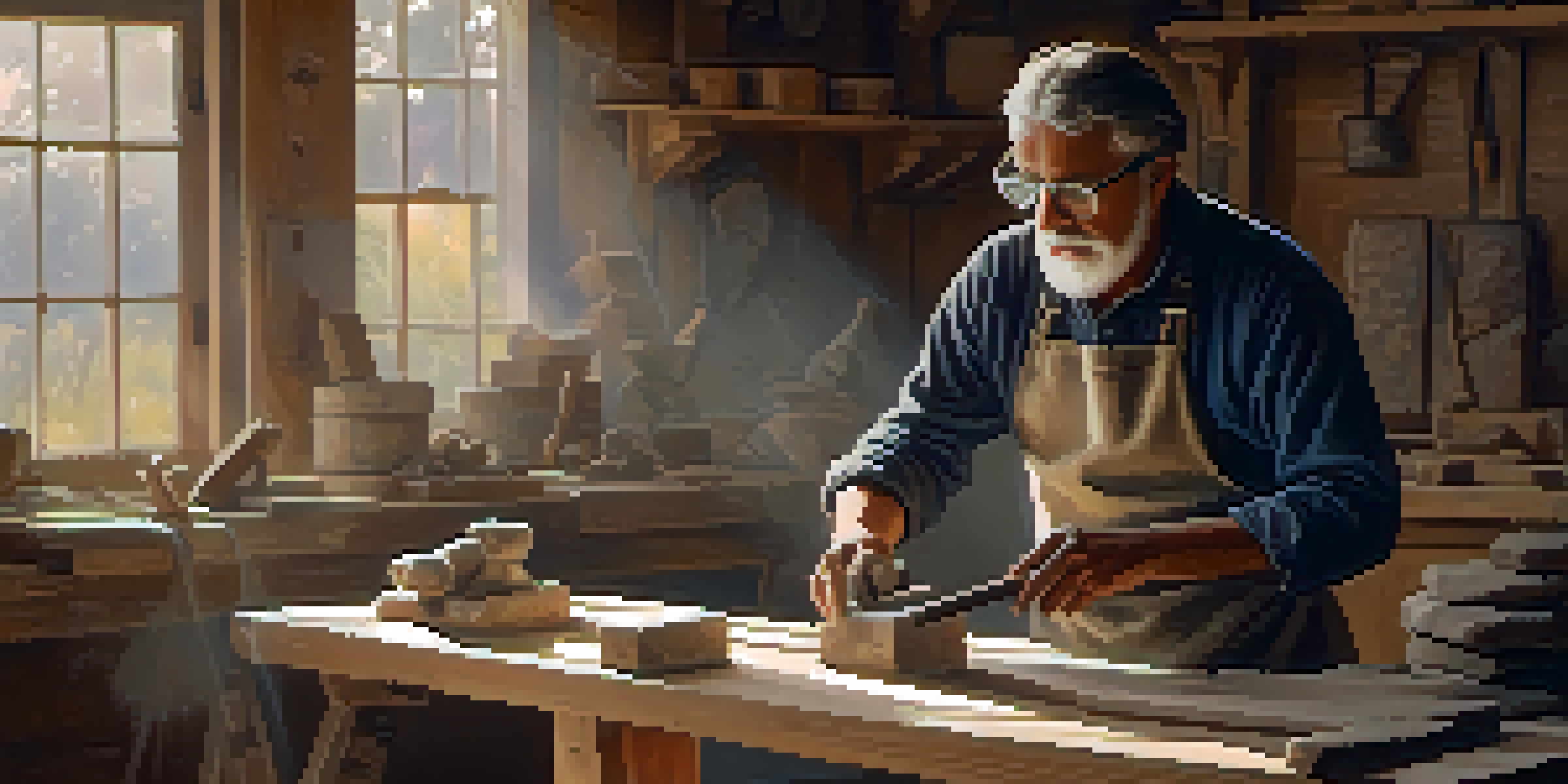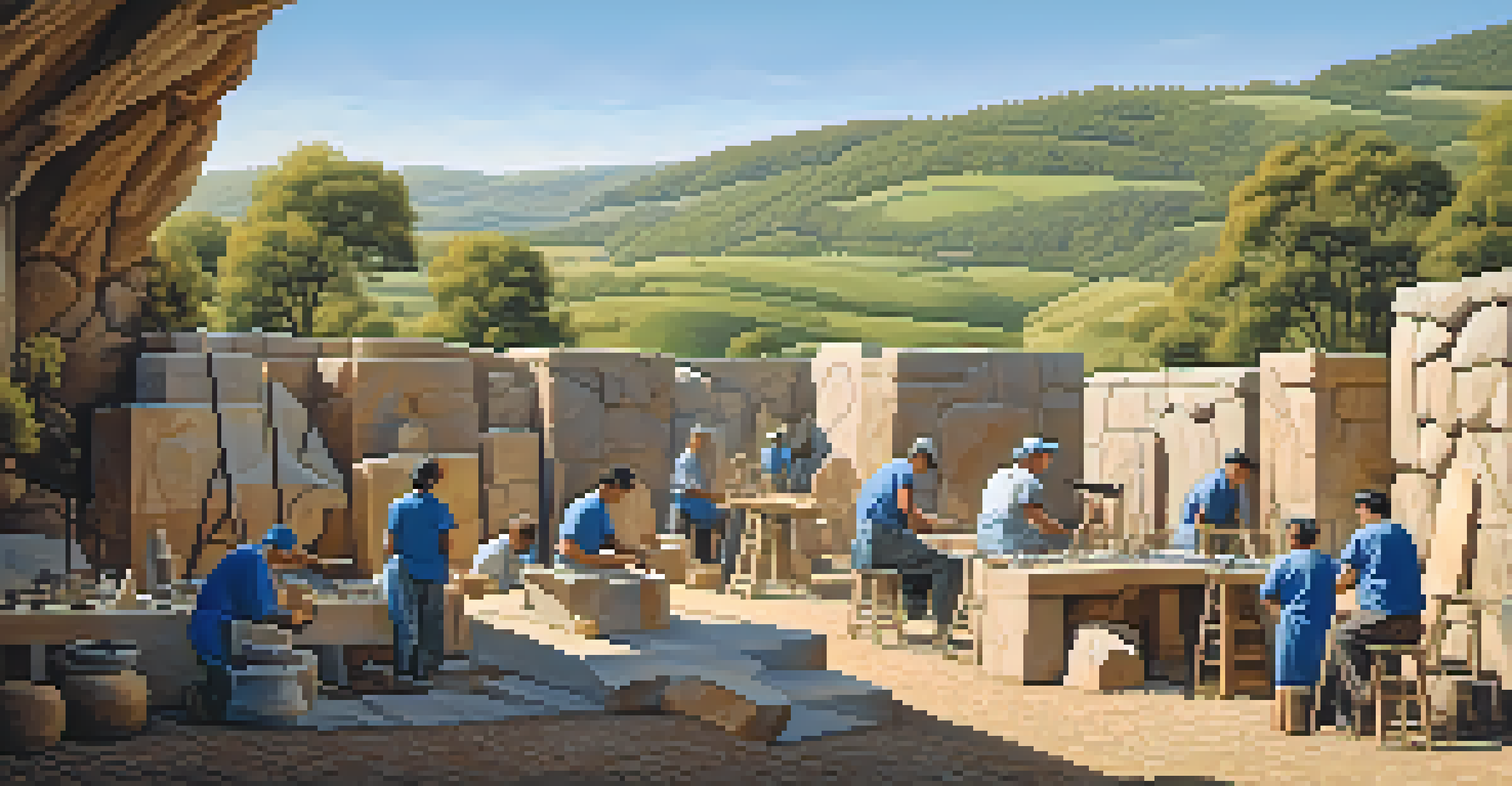Essential Techniques for Carving Stone: A Beginner's Guide

Understanding the Basics of Stone Carving
Before diving into stone carving, it's important to understand what it entails. Stone carving is an ancient art form that involves shaping and refining stone to create sculptures or functional items. Beginners should familiarize themselves with different types of stone, such as marble, granite, and limestone, as each has unique properties that affect how they can be carved.
Art is the most beautiful of all lies.
Selecting the right stone is crucial for your project. Softer stones like soapstone or alabaster are often recommended for beginners due to their ease of carving. In contrast, harder stones require more specialized tools and techniques, making them challenging for newcomers. Think of it like choosing the right canvas for a painting; the right stone can dramatically influence your creative process.
Once you understand the basics, you'll be more confident in your carving journey. This foundational knowledge not only helps in choosing materials but also prepares you for the tools and techniques you'll soon explore.
Essential Tools for Stone Carving
Having the right tools can make all the difference in your stone carving experience. Basic tools include chisels, hammers, rasps, and files—each serving a unique purpose. For instance, chisels are used for removing larger chunks of stone, while rasps help refine the surface and add detail.

Investing in quality tools is worth it, as they can enhance your efficiency and the quality of your work. Take the time to research and select tools that feel comfortable in your hands. It's similar to a chef finding the right knife; the right tool can elevate your craft and make the process more enjoyable.
Choose the Right Stone Wisely
Selecting the appropriate type of stone, such as softer stones for beginners, is essential for a successful carving experience.
As you advance in your skills, you may want to explore power tools, such as angle grinders or rotary tools. While they can speed up the process, they also require careful handling and safety precautions, making it essential to understand their use thoroughly.
Safety First: Essential Precautions
Stone carving can be a rewarding yet hazardous activity if safety precautions aren't taken seriously. Always wear protective gear, including goggles, gloves, and a dust mask, to shield yourself from flying debris and dust inhalation. Think of these items as your armor, protecting you as you embark on your creative journey.
The sculptor must search until he finds the form that is hidden in the stone.
Proper workspace organization is also crucial for safety. Ensure your work area is well-lit and free of clutter, allowing you to move freely and focus on your carving without distractions. Imagine trying to cook in a messy kitchen; a tidy space promotes better concentration and reduces the risk of accidents.
Lastly, take your time and work at a comfortable pace. Rushing can lead to mistakes and injuries, so being patient with your craft is key. Remember, stone carving is as much about the process as it is about the final product.
Basic Techniques for Stone Carving
As a beginner, it's helpful to start with basic carving techniques like point chiseling and flat chiseling. Point chiseling involves using a pointed chisel to remove large amounts of material, while flat chiseling smooths out surfaces. These techniques are foundational and will serve you well as you develop your skills.
Another essential technique is the use of the hammer. Learning how to control the force and angle of your strikes can drastically impact the outcome of your work. Think of it as learning to swing a tennis racket; the right technique can improve your performance and results.
Safety is Paramount in Carving
Wearing protective gear and maintaining an organized workspace are crucial to ensure safety while stone carving.
Practicing these techniques on scrap stone before starting your actual project can also build your confidence. Just like learning to ride a bike, the more you practice, the more natural it will feel, leading to improved results in your carving endeavors.
Creating a Simple Stone Carving Project
Once you've grasped the basics, it's time to embark on your first stone carving project! Start with something simple, like a small sculpture or a decorative piece. This will allow you to apply the techniques you've learned while keeping the experience enjoyable and manageable.
Before you begin, sketch your design on paper. Visualizing your project helps you plan the necessary steps and tools needed. It's similar to drafting a blueprint before building a house; having a clear plan can save time and frustration.
As you carve, remember to step back frequently to assess your progress. This practice allows you to appreciate your work and make adjustments as needed, ensuring that your final piece meets your initial vision.
Finishing Touches: Polishing Your Work
Once your carving is complete, it's time to add those finishing touches that will elevate your piece. Polishing is an essential step that enhances the stone's natural beauty and provides a smooth surface. Depending on the type of stone, you may use sandpaper, polishing pads, or even specialized polishing compounds.
Take your time during the polishing process, as rushing can lead to uneven surfaces. Think of polishing as the final icing on a cake; it's what makes your work truly shine and stand out. A well-polished piece can transform an ordinary sculpture into something extraordinary.
Practice Basic Techniques Regularly
Developing foundational techniques, like point and flat chiseling, through consistent practice will build your confidence and skills.
Additionally, consider sealing your stone if it's porous. This step not only protects your work from stains and moisture but can also enhance the color and texture of the stone. Just like a protective coat on a wooden table, sealing adds longevity to your creation.
Resources for Further Learning and Inspiration
As you delve deeper into stone carving, it's beneficial to seek out resources that can enhance your skills and inspire your creativity. Books, online tutorials, and local workshops can provide valuable insights and techniques from experienced carvers. Don't hesitate to explore various sources to find what resonates with you.
Joining a community of fellow carvers can also be a great way to learn. Online forums and social media groups allow you to share your work, ask questions, and receive feedback. It's akin to joining a book club; engagement with others can enrich your experience and offer new perspectives.

Lastly, visit local galleries or museums to study the work of established stone carvers. Observing different styles and techniques can spark new ideas and motivate you to push your creative boundaries. Remember, inspiration can come from anywhere, so keep your eyes open!